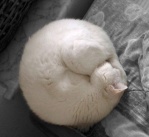Exposure and rendering 2
Page 1 of 1
 Exposure and rendering 2
Exposure and rendering 2
Image capture is only part of the image forming process. Regardless of material, some process must be employed to render the latent image captured by the camera into a viewable image. With slide film, the developed film is just mounted for projection. Print film requires the developed film negative to be printed onto photographic paper or transparency. Digital images may be uploaded to an image server (e.g., a photo-sharing web site), viewed on a television, or transferred to a computer or digital photo frame.
A photographer using a tripod for greater stability during long exposure
Prior to the rendering of a viewable image, modifications can be made using several controls. Many of these controls are similar to controls during image capture, while some are exclusive to the rendering process. Most printing controls have equivalent digital concepts, but some create different effects. For example, dodging and burning controls are different between digital and film processes. Other printing modifications include:
* Chemicals and process used during film development
* Duration of print exposure – equivalent to shutter speed
* Printing aperture – equivalent to aperture, but has no effect on depth of field
* Contrast – changing the visual properties of objects in an image to make them distinguishable from other objects and the background
* Dodging – reduces exposure of certain print areas, resulting in lighter areas
* Burning in – increases exposure of certain areas, resulting in darker areas
* Paper texture – glossy, matte, etc.
* Paper type – resin-coated (RC) or fiber-based (FB)
* Paper size
* Toners – used to add warm or cold tones to black and white prints
A photographer using a tripod for greater stability during long exposure
Prior to the rendering of a viewable image, modifications can be made using several controls. Many of these controls are similar to controls during image capture, while some are exclusive to the rendering process. Most printing controls have equivalent digital concepts, but some create different effects. For example, dodging and burning controls are different between digital and film processes. Other printing modifications include:
* Chemicals and process used during film development
* Duration of print exposure – equivalent to shutter speed
* Printing aperture – equivalent to aperture, but has no effect on depth of field
* Contrast – changing the visual properties of objects in an image to make them distinguishable from other objects and the background
* Dodging – reduces exposure of certain print areas, resulting in lighter areas
* Burning in – increases exposure of certain areas, resulting in darker areas
* Paper texture – glossy, matte, etc.
* Paper type – resin-coated (RC) or fiber-based (FB)
* Paper size
* Toners – used to add warm or cold tones to black and white prints

meodingu- Member

-
 Posts : 153
Posts : 153
BDB Credits : 421
Rep : 0
Age : 39
Location : vn hp
Job/hobbies : studient
Page 1 of 1
Permissions in this forum:
You cannot reply to topics in this forum|
|
|

» How can i play texan holden poker in my nokia C3-00?
» Pet Franchisee
» Anyone think these are good for my forum?
» hello everyone
» Features of FM Antenna
» Inventory Management Software for Effective Warehouse Goods Management
» features of Half log siding system
» Things to know before installing a solar power system.